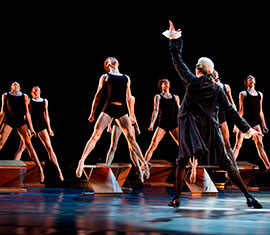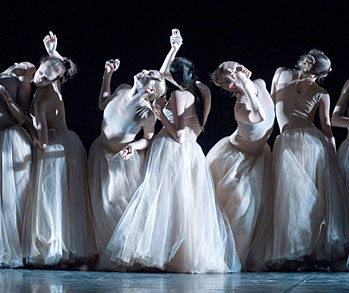Nacho Duato, Mikhailovsky Ballet, London Coliseum | reviews, news & interviews
Nacho Duato, Mikhailovsky Ballet, London Coliseum
Nacho Duato, Mikhailovsky Ballet, London Coliseum
The Mikhailovsky aim to prove their worth as an all-round dance company

The Mikhailovsky Ballet closed their epic two-week Coliseum season with modern works by their director, Nacho Duato, presumably hoping to display their capabilities at all dance forms. Multiplicity. Forms of Silence and Emptiness is a work in two acts first created for the Weimar Arts Festival in 1999.
The music was clearly the inspiration for Duato. The composer features in the work himself, acting as a connecting thread between the disparate collection of dance sequences, which all seemed to have a common purpose: to make music visually identifiable through dance. Considering there’s around 90 minutes of dance, Duato does the complex layering of Bach’s intricate genius proud, using perpetual pedestrian movement to extensive adagio partner-work.
 The dancers communicated a keen understanding of what was needed from them, specifically the men, showing a great use of weight punctuated with buoyant ballon and hazardous slides. More use of the torso would have helped to modify their innate classical aplomb, and the same goes for the head: as the heaviest part of the body it can create a riot of genuine movement.
The dancers communicated a keen understanding of what was needed from them, specifically the men, showing a great use of weight punctuated with buoyant ballon and hazardous slides. More use of the torso would have helped to modify their innate classical aplomb, and the same goes for the head: as the heaviest part of the body it can create a riot of genuine movement.
American Ballet Theatre’s Polina Semionova starred as the Woman in the Black Dress perpetuating the torment buried deep within Bach’s creativity, and though she is a more than expansive mover the real action was often lost under a vast skirt that didn’t accentuate her powerful presence.
Iraqi architect Jaffar Chalabi’s black lacquered industrial set was a formidable presence throughout, but when it eventually uncurled to expose open scaffolding that the entire cast then entered, the staves of Bach’s greatest masterpieces at once came alive again, this time in human form.
The Sunday matinee triple bill didn’t fare as well, with only one of the three pieces achieving the same weight as Friday’s offering. Opening was Without Words, a work originally created in 1998 for the American Ballet Theatre to Schubert (adeptly performed by cellist Vadim Messerman and pianist Marianna Domnikova). The programme notes described the work for eight dancers as “existential”, which could mean everything or nothing. For me the latter option read most clearly, with the nude lycra-clad dancers performing duets that didn’t really develop. The movement felt very one-dimensional in both level and dynamic, although projected visuals of the dancers themselves did help with a sense of relation, but still weren’t enough to truly engage.
Nunc Dimittis followed, taking its name from the Arvo Pärt music used. The overall feel was far more ominous, and a religious connotation felt omnipresent. The upright issue presented itself again in the movement, contributing to an overall static feel. Most concerning was Duato’s use of classroom-style connecting steps throughout, which felt amateurish, if not lazy, by the end. The most interesting point didn't arrive until the penultimate minute, when ballerina Ekaterina Borchenko wrapped herself in hanging red sashes before being hoisted some six feet into the air as the curtain lowered; arresting, but too little too late.
The closing piece – Prelude – was something of a return to form with music by Handel, Beethoven and Britten. This work had a premise: “What Duato experienced at the start of a new period in St Petersburg, and with the Mikhailovsky.” As a female corps de ballet ran from the back of the open stage with their tulle skirts flying in the wind, you instantly realised Duato was acknowledging the history of both the city and theatre, while trying to make his presence felt as a modern dance-maker.
 Highlights included the use of 19th century group formations executed in a freer fashion, with more overt use of tilt, weight and travel. The set design (Duato’s own) also supported the journey between historic and present, using quintessential woodland vistas, and Tsarist chandeliers contrasting with the Coliseum’s bare back wall free of any sumptuous illusions. When the female corps de ballet re-entered, rocking their bodies rigidly from the torso, they looked like a flock of apocalyptic swans about to attack the lone male on stage – more Black Swan than Swan Lake.
Highlights included the use of 19th century group formations executed in a freer fashion, with more overt use of tilt, weight and travel. The set design (Duato’s own) also supported the journey between historic and present, using quintessential woodland vistas, and Tsarist chandeliers contrasting with the Coliseum’s bare back wall free of any sumptuous illusions. When the female corps de ballet re-entered, rocking their bodies rigidly from the torso, they looked like a flock of apocalyptic swans about to attack the lone male on stage – more Black Swan than Swan Lake.
Though not all the work presented was ground-breaking, it confirmed that Duato’s presence in St Petersburg will have done no harm to the audiences or company dancers alike. For some, it will have been an overdue revelation.
rating
Share this article
The future of Arts Journalism
You can stop theartsdesk.com closing!
We urgently need financing to survive. Our fundraising drive has thus far raised £49,000 but we need to reach £100,000 or we will be forced to close. Please contribute here: https://gofund.me/c3f6033d
And if you can forward this information to anyone who might assist, we’d be grateful.

Subscribe to theartsdesk.com
Thank you for continuing to read our work on theartsdesk.com. For unlimited access to every article in its entirety, including our archive of more than 15,000 pieces, we're asking for £5 per month or £40 per year. We feel it's a very good deal, and hope you do too.
To take a subscription now simply click here.
And if you're looking for that extra gift for a friend or family member, why not treat them to a theartsdesk.com gift subscription?
more Dance
 'We are bowled over!' Thank you for your messages of love and support
Much-appreciated words of commendation from readers and the cultural community
'We are bowled over!' Thank you for your messages of love and support
Much-appreciated words of commendation from readers and the cultural community
 Quadrophenia, Sadler's Wells review - missed opportunity to give new stage life to a Who classic
The brilliant cast need a tighter score and a stronger narrative
Quadrophenia, Sadler's Wells review - missed opportunity to give new stage life to a Who classic
The brilliant cast need a tighter score and a stronger narrative
 The Midnight Bell, Sadler's Wells review - a first reprise for one of Matthew Bourne's most compelling shows to date
The after-hours lives of the sad and lonely are drawn with compassion, originality and skill
The Midnight Bell, Sadler's Wells review - a first reprise for one of Matthew Bourne's most compelling shows to date
The after-hours lives of the sad and lonely are drawn with compassion, originality and skill
 Ballet to Broadway: Wheeldon Works, Royal Ballet review - the impressive range and reach of Christopher Wheeldon's craft
The title says it: as dancemaker, as creative magnet, the man clearly works his socks off
Ballet to Broadway: Wheeldon Works, Royal Ballet review - the impressive range and reach of Christopher Wheeldon's craft
The title says it: as dancemaker, as creative magnet, the man clearly works his socks off
 The Forsythe Programme, English National Ballet review - brains, beauty and bravura
Once again the veteran choreographer and maverick William Forsythe raises ENB's game
The Forsythe Programme, English National Ballet review - brains, beauty and bravura
Once again the veteran choreographer and maverick William Forsythe raises ENB's game
 Sad Book, Hackney Empire review - What we feel, what we show, and the many ways we deal with sadness
A book about navigating grief feeds into unusual and compelling dance theatre
Sad Book, Hackney Empire review - What we feel, what we show, and the many ways we deal with sadness
A book about navigating grief feeds into unusual and compelling dance theatre
 Balanchine: Three Signature Works, Royal Ballet review - exuberant, joyful, exhilarating
A triumphant triple bill
Balanchine: Three Signature Works, Royal Ballet review - exuberant, joyful, exhilarating
A triumphant triple bill
 Romeo and Juliet, Royal Ballet review - Shakespeare without the words, with music to die for
Kenneth MacMillan's first and best-loved masterpiece turns 60
Romeo and Juliet, Royal Ballet review - Shakespeare without the words, with music to die for
Kenneth MacMillan's first and best-loved masterpiece turns 60
 Help to give theartsdesk a future!
Support our GoFundMe appeal
Help to give theartsdesk a future!
Support our GoFundMe appeal
 Vollmond, Tanztheater Wuppertal Pina Bausch + Terrain Boris Charmatz, Sadler's Wells review - clunkily-named company shows its lighter side
A new generation of dancers brings zest, humour and playfulness to late Bausch
Vollmond, Tanztheater Wuppertal Pina Bausch + Terrain Boris Charmatz, Sadler's Wells review - clunkily-named company shows its lighter side
A new generation of dancers brings zest, humour and playfulness to late Bausch
 Phaedra + Minotaur, Royal Ballet and Opera, Linbury Theatre review - a double dose of Greek myth
Opera and dance companies share a theme in this terse but affecting double bill
Phaedra + Minotaur, Royal Ballet and Opera, Linbury Theatre review - a double dose of Greek myth
Opera and dance companies share a theme in this terse but affecting double bill

Add comment